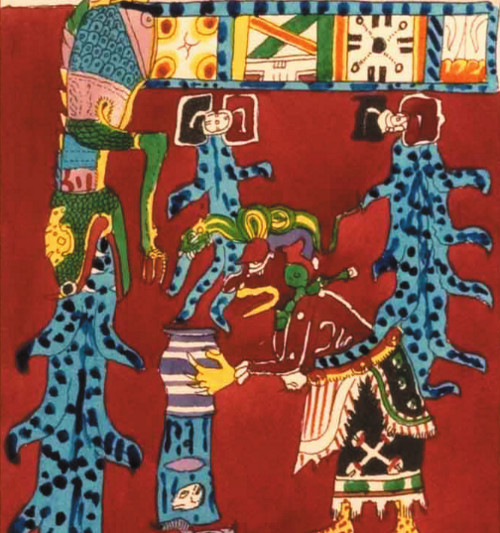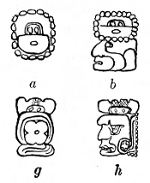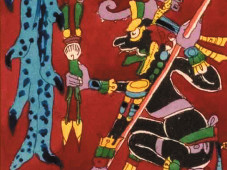
It’s 2012 and the end of the world is on everyone’s mind. This is the year we’ve been told the Mayan calendar ends. Now anyone with half a brain knows this is glorious, glorious hokum, but have you ever actually met someone who knows the Mayan calendar? NO. And here’s why: it’s insanely complicated. It’s a miracle the Mayans got round to creating a civilization at all when they must have spent all their time doing sums and trying to figure out what the hell day of the week it was. So in the interests of learning something obscure and cool, I figured I’d find out what the Mayan calendar actually says.

The Mayan writing system is bizarrely complicated to our eyes. I have a working knowledge of Egyptian hieroglyphs and I can tell you they’re a cakewalk compared to Mayan hieroglyphs. Each glyph is a combination of sign elements that can be depicted in different styles. On top of that each glyph could be drawn either as a rectangular block or as a grotesque face and still mean exactly the same thing. Sometimes the block and the face contain the same elements, but in other cases they look completely different. Then the exact same glyphs were depicted one way when carved in an inscription and another way when written down in a codex. In most cases the inscription forms and the codex forms have only the barest similarity to each other. Is it any wonder it took them forever to decipher this stuff?
The doorway into the decipherment was the numerals and, by extension, the calendar. The Mayans actually had two distinct calendars — the Calendar Round and the Long Count. The Long Count is the one we’re interested in for the end of the world, but the Calendar Round is a way better demonstration of just how crazy the Mayans really were. So let’s start there, shall we?
There were 20 days in a Mayan week. By prefixing a number from 1–13 to the day of the week you could produce a cycle of 260 days3 called the tzolk’in. But the Mayans knew that 260 days didn’t make a year. They had a separate solar year of 365 days divided into 18 months called the haab’. The tzolk’in and the haab’ had different numbers of days in them so they were always out of sync, except for once every 52 years4 when they would come into alignment again. By giving the day in both the tzolk’in and the haab’, the Mayans could uniquely designate every date within a 52 year period. Each period of 52 years was called a Calendar Round because once the cycle was complete it would begin again the start.
But 52 years isn’t all that long. The Mayans needed a different way of naming the date in longer stretches of time. That’s why they used a second calendar called the Long Count. Mercifully the Long Count is much simpler than the Calendar Round. The Long Count is essentially a base system designed to count large numbers of days. By simply numbering the day they could uniquely designate every day over a period of thousands of years. Here’s the maths:
| 1 k'in | = | 1 day | ||
| 20 k'ins | = | 1 winal | = | 20 days |
| 18 winals | = | 1 tun | = | 360 days |
| 20 tuns | = | 1 ka'tun | = | 7,200 days |
| 20 ka'tuns | = | 1 cycle | = | 144,000 days |
| 20 cycles | = | 1 great cycle | = | 2,880,000 days |
So what’s the big flap about? The flap, it turns out, is because we’re approaching the end of the 13th cycle. On the 20th of December this year the Mayan calendar will go from 12.19.19.17.19 (i.e. 12 cycles, 19 ka’tuns, 19 tuns, 17 winals and 19 k’ins) to 13.0.0.0.0. It’s not even the end of the calendar, it’s just the numbers ticking over. And when we get to the end of the 19th great cycle in the year 4772 AD?
Nothing. It turns out there are even greater units that the Mayans almost never used. And why would they? They’re not going to happen for literally millions of years. The Mayans may have been good at planning in advance, but they weren’t that good.

Numbers are nice but we’ve been neglecting one significant party: the gods. Oh yes, those hairy thunderers have weighed in on this issue too. Even though the calendar itself won’t be ending, Mayan mythology has it that the current world was created at the end of Cycle 13 of the previous world. Counting back using the Long Count, people calculated this date was the 11th of August 3114 BC. If the gods decide they’ve got tired of the past 5,000 years they’re going to smash the place up and start a new one. I would panic if I hadn’t heard that one before. Heck, I’ve said it myself a few times just to get out of a bad date.
What this whole wingding boils down to is round numbers. Folks love a number with lotsa pretty zeroes on the end. Remember the huge kerfuffle about the end of the world in the year 2000? Didn’t happen then either, did it? But it seems impossible for these dates to tick over without someone getting into a state over it. If you kept an eye on every calendar from every civilization, you’d been in a neverending panic about the end of some time span in one calendar or another. What a way to live. But I do owe those doomsayers a debt of gratitude. Without all the flapdoodle about the Mayan calendar I would never have got interested enough to actually find out how it worked. And isn’t it pretty cool now you know about it too? Useless, I grant you, but nothing utilitarian was ever really beautiful.
Notes
-
Morley, 32. ↩
-
Morley, 24. ↩
-
I’m putting most of the maths in the footnotes. You get 260 days because 20 days and 13 numbers don’t sync up. Each cycle of 20 days and 13 numbers repeats again and again until the two come into alignment again at the least common multiple of 13 and 20, which happens to be 260. ↩
-
Woo, more maths. 18,980 days is the least common multiple of 260 and 365, thus producing 52 years of 365 days each. ↩
-
Morley, 32. ↩
Bibliography
-
The Dresden Codex. Kingsborough ed. FAMSI. Online.
-
Morley, Sylvanus Griswold. An Introduction to the Study of the Maya Hieroglyphs. New York: Dover Publications, 1975. Print.